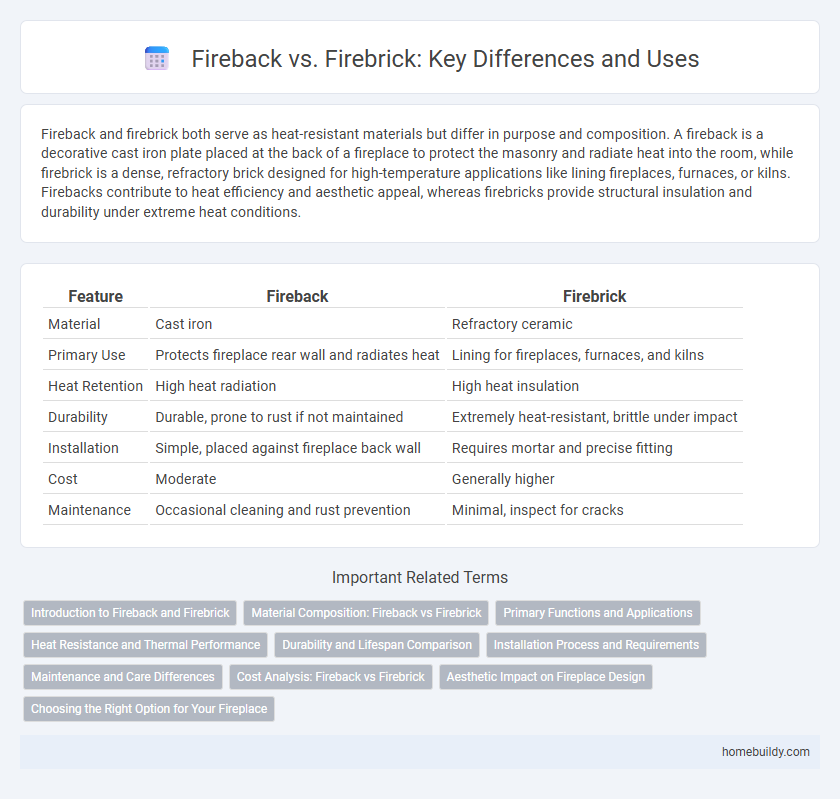Fireback and firebrick both serve as heat-resistant materials but differ in purpose and composition. A fireback is a decorative cast iron plate placed at the back of a fireplace to protect the masonry and radiate heat into the room, while firebrick is a dense, refractory brick designed for high-temperature applications like lining fireplaces, furnaces, or kilns. Firebacks contribute to heat efficiency and aesthetic appeal, whereas firebricks provide structural insulation and durability under extreme heat conditions.
Table of Comparison
| Feature | Fireback | Firebrick |
|---|---|---|
| Material | Cast iron | Refractory ceramic |
| Primary Use | Protects fireplace rear wall and radiates heat | Lining for fireplaces, furnaces, and kilns |
| Heat Retention | High heat radiation | High heat insulation |
| Durability | Durable, prone to rust if not maintained | Extremely heat-resistant, brittle under impact |
| Installation | Simple, placed against fireplace back wall | Requires mortar and precise fitting |
| Cost | Moderate | Generally higher |
| Maintenance | Occasional cleaning and rust prevention | Minimal, inspect for cracks |
Introduction to Fireback and Firebrick
Firebacks are cast iron plates positioned at the back of fireplaces to protect masonry from heat while radiating warmth into the room, enhancing heating efficiency. Firebricks, made from refractory ceramic, line the interior of fireplaces and wood stoves, resisting intense heat and thermal shock to safeguard structural integrity. Both firebacks and firebricks are essential components in traditional and modern fireplaces, serving distinct roles in heat protection and heat distribution.
Material Composition: Fireback vs Firebrick
Firebacks are typically made from cast iron or steel, designed to withstand high temperatures and reflect radiant heat into the room. Firebricks, on the other hand, consist of refractory ceramic materials with alumina and silica content that provide superior heat resistance and thermal insulation. The difference in material composition determines durability, heat retention, and suitability for various fireplace applications.
Primary Functions and Applications
Firebacks serve as protective barriers inside fireplaces, reflecting heat into the room and safeguarding the masonry from damage, making them essential in wood-burning fireplaces. Firebricks are high-temperature resistant materials used primarily to line the interior of fireplaces, furnaces, and kilns, providing structural insulation and durability under extreme heat. While firebacks enhance heat distribution and longevity of the fireplace structure, firebricks primarily ensure thermal insulation and mechanical strength in high-heat environments.
Heat Resistance and Thermal Performance
Firebacks offer superior heat resistance compared to firebrick, sustaining temperatures up to 2000degF without cracking or deforming. Their dense cast iron composition provides excellent thermal performance by efficiently radiating heat back into the room, enhancing fireplace warmth. Firebrick, while durable, typically withstands lower temperatures and does not radiate heat as effectively, making firebacks a preferred choice for maximizing energy efficiency in fireplaces.
Durability and Lifespan Comparison
Firebacks are typically made from cast iron, providing superior durability and resistance to cracking compared to firebricks, which are ceramic and more prone to chipping under extreme heat. The lifespan of a fireback often exceeds 20 years with minimal maintenance, while firebricks may require replacement every 5 to 10 years due to thermal stress and erosion. This durability advantage makes cast iron firebacks a more long-term investment for fireplace protection and heat retention.
Installation Process and Requirements
Firebacks generally require simpler installation compared to firebricks, as they are pre-formed cast iron or steel plates designed to fit directly against the rear wall of a fireplace. Firebricks demand precise cutting and mortar application to create a durable, heat-resistant lining, often necessitating specialized skills and materials for proper adherence and thermal insulation. Installation of firebricks must comply with specific thickness and alignment standards to ensure maximum heat retention and structural safety within combustion chambers.
Maintenance and Care Differences
Firebacks require minimal maintenance due to their durable cast iron construction, which withstands frequent heating cycles without cracking. Firebricks, made from refractory ceramic material, demand careful handling to avoid chipping and require regular inspection for cracks to maintain effective heat insulation. Both materials benefit from periodic cleaning, but firebacks are generally more resilient to wear and easier to maintain over time compared to firebricks.
Cost Analysis: Fireback vs Firebrick
Firebacks generally offer a more cost-effective solution compared to firebrick, with prices varying based on material composition and design complexity but typically lower installation expenses. Firebrick, while more expensive upfront due to its refractory quality and durability, provides enhanced thermal efficiency and longer lifespan, potentially reducing long-term replacement costs. Evaluating total cost of ownership, including installation, maintenance, and durability, often positions firebacks as the budget-friendly option for homeowners prioritizing initial investment.
Aesthetic Impact on Fireplace Design
Firebacks offer intricate designs and artistic patterns that enhance the visual appeal of fireplace interiors, creating a focal point with historical or decorative charm. Firebricks, primarily functional, provide a uniform and utilitarian appearance that supports heat retention but lacks ornamental features. Choosing firebacks significantly elevates the aesthetic impact, blending both functionality and craftsmanship in fireplace design.
Choosing the Right Option for Your Fireplace
Fireback and firebrick serve distinct purposes in fireplace construction and maintenance, with firebacks typically made of cast iron to protect the back wall and radiate heat efficiently, while firebricks are refractory bricks designed to withstand high temperatures and insulate the firebox. Selecting the right option depends on factors such as desired heat retention, durability, and budget; firebacks offer enhanced heat reflection and aesthetic appeal, whereas firebricks provide superior thermal protection and longevity for the fireplace structure. Considering these differences ensures optimal fireplace performance and safety tailored to specific heating needs.
Fireback vs Firebrick Infographic

 homebuildy.com
homebuildy.com